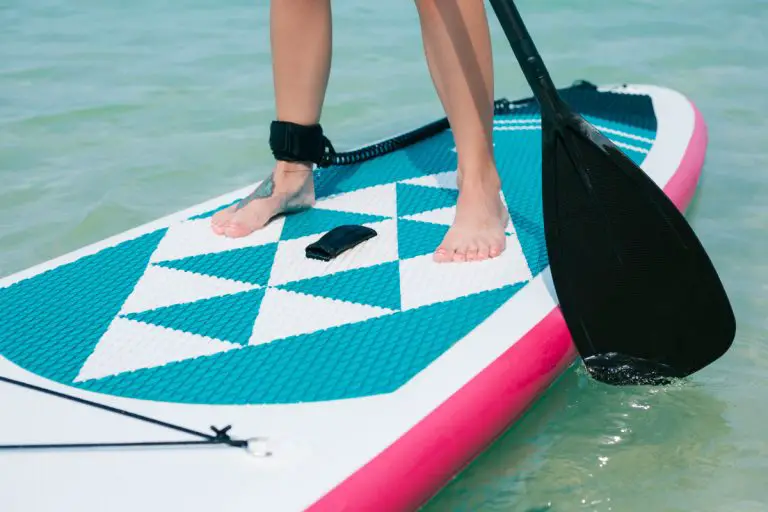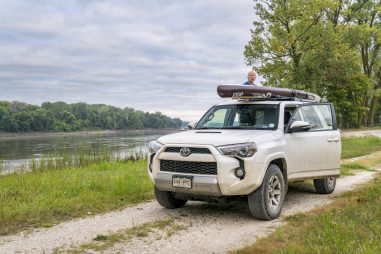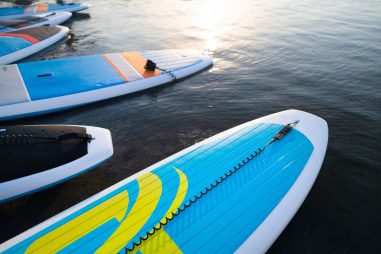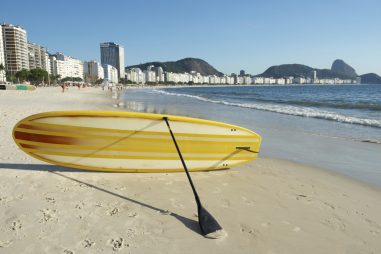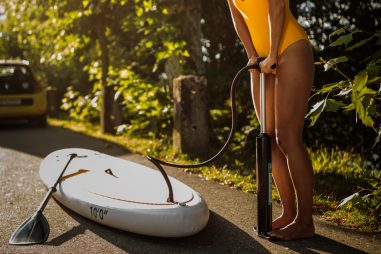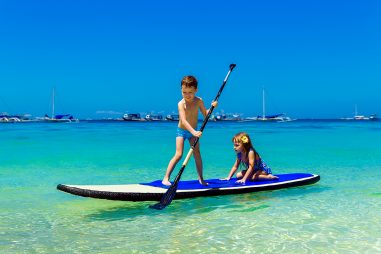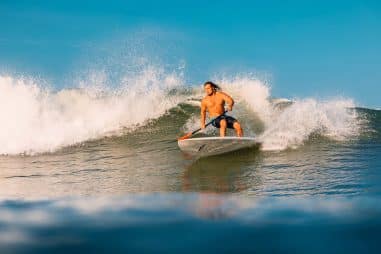In general, paddle boarding is considered one of the most famous water sports due to its ease of use. However, it’s a minimalist sport that requires a few essential gear when you get the hang of it.
How Do I Prepare for Paddle Boarding?
You need to gear up before using a paddle board. As a beginner, it’s crucial to know the basic requirements of paddle boarding before you can take on the waves. In addition, even though paddle boarding is user-friendly, it’s essential to properly prepare the safety measures.
- Paddle Board: Paddle boards are available in a variety depending on your purpose and requirement. However, renting a paddle board is recommended instead of buying one if you’re a beginner.
- Paddle: Like paddle boards, paddles are available in various types and functions. While choosing your paddle, it’s essential to consider selecting a foot longer than your overall height.
- Leash: Preparing a leash is not an optional accessory. It’s one of the necessary preparations you need to ensure your paddle board does not drift away from you.
So, make sure to secure a leash before planning to take your paddle board out to avoid any life-threatening mishaps.
- Life Jacket: Generally, life jackets are only required for kids and not adults. However, there are certain shores where adults must use a life jacket while paddle boarding. Be sure to double-check and adhere to your local beach guidelines.
- Whistle: Another measure of safety precaution is bringing a whistle along. Aside from signaling for help, it’s a great device to communicate with your peers.
- Lights: It’s vital to prepare lights for obvious reasons. So, if you’re planning to paddle board until dusk, make sure you have one.
- Clothing: Clothing preparation depends on the weather. If the weather is warm, the usual swimsuit or surf shorts would be acceptable. However, if it’s cold out, prepare thick clothing to protect yourself against the harsh weather.
How Do You Attach a Leash to a Paddle Board?
There are two types of leash attachments on a paddle board; it all depends on whether it is a hardboard or an inflatable board.
Hard Paddle Board
You need to remove the nylon cord from the velcro and loop it through the slot of the built-in leash plug.
It’s essential to make sure the string isn’t too long. Next, feed the velcro through the string and securely strap it in. After you have securely strapped in the velcro, make sure the widest and thickest part of your leash’s velcro is over the rail section at the back of the board.
By doing this, you’ll prevent damaging your board. In addition, you can leave the nylon string looped in the leash plug for future use.
Inflatable Paddle Board
It comes with a stainless D-ring where your leash will be looped in. The installation is straightforward. Just make sure you strapped the leash securely.
Where Do You Put the Leash on a Paddle Board?
Leashes are commonly located at the tail of your paddle board. Depending on the type of board mentioned above, the installation of the leash differs. After attaching the leash to your board, it will be connected to your ankle using the ankle strap.
How Do You Carry a Paddle Board?
In carrying a paddle board, first, you need to be careful not to strain your back. Next, it’s vital to make sure your back is straight and bend your knees to lift your board. From there, you have at least four options on how to carry a paddle board:
- Carry Handle: The most common way to carry a paddle board is by grabbing the handle located at its center. You can simply hold the board with one hand as you walk toward the water.
- Shoulder-Strap Carry: Instead of using your arms, carrying the paddle board via shoulder strap is an easier option. Take note that you need to buy a shoulder strap.
Some boards offer variations that include built-in plugs or rings where you can directly attach the strap to the board. However, there are options with no plugs to attach the shoulder strap.
For this, you need to use two separate straps that will be used around the paddle board. After that, you can adjust the clips of the straps to one side and attach the shoulder strap.
- Head Carry: Also called the ‘classic surfer’ carry style, this carrying technique is ideal for long walks compared to the first two options.
It’s ideal for long-duration walks as the arms could quickly get tired. Nevertheless, it’s recommended to mix carrying techniques to avoid body strain.
- Board Carrier: If you’re looking for a more convenient way to carry your board, you can try investing in a carrier. You can just load the board onto the carrier and pull it towards your destination.
How Do You Carry an Inflatable Paddle Board?
You can carry an inflatable paddle board in the same way as a hardboard. Although, compared to a hardboard, it’s more convenient to transport the inflatable board to and from your destination as it’s more lightweight.
How Do You Start Paddle Boarding?
To start paddle boarding, you need to pin down all the basics, such as equipment, techniques, and body condition. Although paddle boarding is considered easy, it’s important to research the necessities beforehand.
- Equipment: Preparation is vital in any kind of water sport. As a beginner, you should familiarize yourself with the required gear to ensure your safety.
- Technique: From carrying to standing, paddle boarding has specific techniques that you need to be familiarized with. Don’t worry. All basic paddle boarding techniques are easily digestible for beginners.
- Body Condition: Paddle boarding requires total body coordination. Therefore, it’s recommended to ensure your body condition before attempting to start paddle boarding.
How Do You Get on a Paddle Board?
Before getting on your paddle board, it’s suggested to make sure the fin behind the board does not touch the sand. So only put down your board after taking a few steps into the water. Next, get on the board by putting your knees on either side of the carry handle.
From there, you have the following options on how to use your paddle board while standing, kneeling, sitting, or lying down.
How Do You Get a Paddle Board Off the Dock?
First, place the paddle board in the water parallel to the dock. Next, you have two options on how to mount the board from a dock:
- Kneeling Position: You must kneel on the dock next to the board. Afterward, place the paddle across the board.
Then you must hold the board’s rails as you move your knees onto the board. After mounting the board, push off the dock, and you can start paddling while on your knees.
- Standing Position: Start by sitting on the dock next to the board. Then, place one hand on the dock while the other holds the paddle. Next, put your feet near the middle at the board’s edge.
It’s important to make sure the blade of your paddle is in front of your feet and facing the middle of the board. Using the hand gripping the dock, push yourself up until you gain balance and manage to stand on the board.
While gaining balance, you can also use the paddle to help you. After ensuring stability on the board, it’s time to paddle away from the dock.
How Do You Stand Up on a Paddle Board?
After getting on the board while on your knees, make sure you place a steady grip on the paddle as your move it forward. Be sure to keep your hold as wide as your board. It will keep you stable while attempting to stand up.
Second, place your feet onto the board beside your knee and stand up while looking forward. As you stand up, your grip on the paddle should change. For example, one of your hands should be holding the top while the other grasps the middle.
Remember that you have to start paddling once you manage to stand up with eyes facing forward. Therefore, it’s best to avoid common mistakes such as leaning forward or looking down at the water — such actions will only make you lose balance. Instead, your back must be straight, chest forward, and look straight at the horizon.
Where Is the Best Place to Stand on a Paddle Board?
The middle of the paddle board is the best place to stand and ensure proper balance. You can use the carry handle as an indicator to locate the center. By doing that, you can accurately place your feet or knees onto the paddle board.
Where Do You Put Your Feet on a Paddle Board?
It’s important to make sure your feet are correctly placed on each side. This applies whether you’re lying, kneeling, or standing. For example, if you’re standing on the paddle board, it’s best to equally distribute your weight in the middle of the board.
How Do You Walk on a Paddle Board?
Keep your knees slightly bent and straighten your back so you can freely walk on the paddle board without losing balance. It’s also vital to keep your head centered on the board as you move around. Furthermore, it’s essential to make sure your weight is equally distributed throughout to avoid losing balance.
How Do You Move Your Feet on a Paddle Board?
You can move your feet on the paddle board one at a time while ensuring an equally distributed weight on the board. It’s important to make sure your toes are facing forward. For beginners, you can use the paddle as a point of contact.
First, place the paddle in the middle of the board. From there, you should be more comfortable moving around the board. It’s also possible to put a little weight on the paddle as you move your feet around.
Is It Hard to Stand Up on a Paddle Board?
It’s not hard to stand up on a paddle board. You’ll achieve proper balance as long as you keep your back straight, push your chest forward, and look straight ahead. Although it takes a couple of attempts as a beginner, you’ll be surprised at how fast you get the hang of it.
Do You Have to Stand on a Paddle Board?
Aside from standing, you can assume more positions while using the paddle board. For example, it’s possible to sit, kneel, or even lay down on your chest. The variation in using a paddle board offers versatility, making it a fun and user-friendly water sport.
Can You Kneel on a Paddle Board?
It’s possible to use the paddle board while kneeling. It’s the best way to relax after standing for several minutes. For some people, it’s easier to paddle while kneeling, especially if it’s windy. It’s also a recommended position while making your way through low areas.
Can You Sit on a Paddle Board?
If you’re more comfortable sitting on a paddle board, it’s fine to use it that way. However, it’s important to note that paddle boarding has no rules in terms of usage. So aside from standing, kneeling, and sitting, you can even do yoga on the board.
What Is a Prone Paddle Board?
Prone paddle boarding is simply the traditional version of paddle boarding. It’s the term used when you use the paddle board on your knees or lying face down. Instead of using a paddle, you’ll have to use your hands in propelling yourself and the board forward.
How Hard Is Prone Paddle Boarding?
Prone paddle boarding is easy even for beginners. It’s more straightforward compared to standup paddle boarding. So, you don’t need to practice the proper techniques to grab a paddle since you’ll be using your hands.
How Do You Paddle a Straight Line on a Paddle Board?
It’s recommended to always paddle close to the board’s edge to go in a straight line. Make sure to grip the handle apart— the top arm grips the uppermost handle while the other hand is placed on the shaft.
Once you familiarize yourself with the proper handling of the paddle, here are the steps to paddle in a straight line:
- Keep the paddle shaft vertical to the board with the angled blade facing forward
- Straighten your lower arm to enter the blade into the water while your top arm pushes downwards.
- Always face ahead with your back straight and chest out to balance the board. Don’t forget to position yourself in the middle with your feet on each board edge.
- Paddle strokes should be clean and smooth.
- Be sure to extend each stroke as far forward as possible.
- Next, your stroke should exit the water when its blade is in line with your feet.
- As the blade exits the water, be sure to twist your wrist.
- Don’t splash water on your board while paddling. Remember, clean strokes only.
In paddling, using only the tip of the blade is considered one of the common mistakes of beginners. So don’t forget to keep your blade fully submerged in the water.
How Do I Keep My Paddle Board Straight?
Never forget to paddle near the board at all times. The most common mistake of beginners often involves the direction of your paddle. Any change in angle will cause your board to swerve away from your intended path.
How Do You Turn on a Paddle Board?
There are a lot of techniques to turn your paddle board. However, as beginners, you have at least two options— the sweeping turn and back paddle. The sweeping turn is the most natural and basic technique in paddle boarding.
- Start by adjusting yourself into a wide stance.
- Keep your knees bent to ensure a low stance while turning to maintain your balance.
- Twist your torso and place your paddle in the direction you want to turn.
- Sweep your blade in a wide arch towards the board’s tail.
- Keep paddling in the same direction and side until the board’s nose turns to your preferred direction.
Meanwhile, another turn you can perform is the back paddle. It’s a faster alternative compared to the sweeping turn. You can simply drag the paddle backward on the side of the direction you want to head towards.
How Do You Stop on a Paddle Board?
Lift your paddle, dip it near the board’s tail, and drag it forward to perform a reverse stroke. This action will help you slowly stop your board. However, it will cause your board to turn at the same time.
How Do You Swim With a Paddle Board?
Simply lie on your chest on the board and use your hands like a paddle. This technique is also a variation of prone paddle boarding. However, if you want to swim on the water, this might be difficult as you’re leashed to the board.
How Do You Get Back Up on a Paddle Board After Falling Off?
You need to utilize the center handle for you to get back on the board. So first, swim towards the edge of the board and grab it. Next, kick your feet behind you and reach for the center handle. Once you grab the handle, slide yourself onto the board with your upper body first.
Why Is My Paddle Board Sinking?
You may be standing off-center of your board. Your paddle board may be sinking because you’re too near the front. It’s also possible that you are standing almost at the tail of your board.
To avoid sinking your paddle board, it’s important to keep in mind to keep your feet equally distributed on each side of the board in the middle.
It’s best to use the carry handle located at the center as your basis. Be sure to always place your feet in parallel to it. By doing this, you’ll avoid sinking yourself.
Can You Anchor a Paddle Board?
Yes, it’s possible to anchor a paddle board. It’s even considered as an excellent accessory for your paddle board. By using an anchor, you can keep your board in one spot. It’s a necessary add-on if you want to go fishing or perform yoga on your paddle board.
How Do You Put a Paddle Board Back on the Dock?
You can place your paddle board back on the dock by pulling the leash plug at the tail. Once the leash plug is grabbed, you can pull the paddle board back onto the dock. As you pull your board, be mindful of the paddle board’s bottom as it might get damaged.
You have two options on how to get yourself on the dock:
- Stepping: Start by slowly paddling towards the edge of the dock. Once your board is parallel to the dock, start by stepping one foot onto the dock until you fully get off your board. As you lift yourself, you can steady the board using the paddle.
- Sitting: Simply sit down at the edge once your board is parallel.
Finally, you can set the board down, pick it up and you’re ready to go.
How Do You Use an Inflatable Paddle Board?
Using an inflatable paddle board is easy. It’s almost the same as a hardboard, except you need to set up an inflatable first. You need to pump air into an inflatable paddle board to use it, for starters.
Here’s a step-by-step instruction on how to set up this type of paddle board:
- Unroll your inflatable paddle board on the ground.
- You’ll find a plug next to the D-ring at the board’s tail. Unplug the valve, and you’ll find a yellow pin.
- Push and twist the pin down to prevent the air from escaping. After doing this, the yellow pin will spring up.
- You can now attach your pump’s hose to the valve by pushing down and twisting it clockwise.
- Now, you can pump air into the inflatable paddle board.
- After forming the paddle board, you can push the pin back into place and cover the valve.
Using an inflatable paddle board doesn’t end with just pumping in the air. Next, you need to securely snap in the fin below the board. This installation is straightforward as it’s easy to attach and does not need other tools.
Depending on the set you bought, you might need to set up the paddle. Then, all you need to do is attach the bottom blade, middle shaft, and upper shaft. Then, finally, you can start using your inflatable paddle board.

